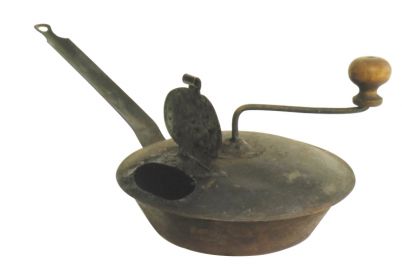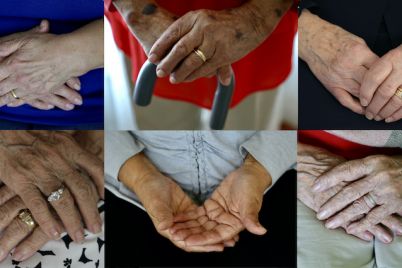Mauro Peressini is on the main floor of the Canadian Museum of Civilization personally conducting a tour of the new exhibit Presenza: A New Look at Italian-Canadian Heritage as a welcoming gesture to a host of lenders and friends. His retinue includes a publicist, a photographer and an assistant. All are beaming with pride, as they congratulate and are congratulated for this epoch-making tribute to the Italian-Canadian identity. One hour from now, the official opening of the Exhibit will be celebrated in a formal ceremony.
Curator and chief architect of the Exhibit, Peressini at times is a blur as he dashes through the 750 square metres of the Exhibit, home to some 300 items of Italian-Canadian lifestyle memorabilia. Gesticulating and glad-handing, the small crowd finds itself in front of a large wall screen on which is projected information related to the “community” category. The screen comes alive with images of interviews conducted with fifty lenders from Vancouver, Calgary, Winnipeg, Thunder Bay, Sarnia, Toronto, Ottawa and Montreal. Also found in this section is a circular base with glass top, in which Compardo’s championship-round bocce balls are displayed.
Peressini is off and back again! This time, with newly arrived friends in tow, he speeds his way to the video monitors, four of which are connected to videocassette players and another one linked to a computer. Suddenly members of his entourage are heard laughing and seen congratulating one another in uniquely Italian style. It’s obvious that they are among those whose testimonials have been chosen for this staged reflection of Italian-Canadian heritage. Encounters like these occur throughout the six sections that make up this epic exposition on the heritage and day-to-day lives of Italian Canadians.
Where my personal sense of awe first took root is not clear to me. Perhaps it was in the foyer where a notable number of passports, representative of the ones used by a million or more Italian immigrants, is on display. If not, surely it happened at the site of the authentic Venetian gondola or the wood crafted mini-replica of the Duomo of Milan, or on seeing Giuseppe Amendola’s classic 1947 Fiat 500, or Bruno Di Giorgio’s 1885 organetto by Ruggieri. The collection arouses one’s sense of identity quite convincingly. As I viewed each of the individual mementos, from cooking utensils to custom-made tools, a memory-tracer of personal family members, long deceased, reverberated from sight to mind to heart.
We intersect Mauro Peressini, thanks to one of his assistants, at the Valigia. This is the suitcase fashioned by Tony Mazzega, woodcarver extraordinaire. His creation is so precise that it is often mistaken for the real thing. Visitors walking past the masterpiece do a double-take and retrace their steps when they are told that the object is actually made of wood. The expressions are those of sheer astonishment. Originally a railway section hand turned baker specializing in creative cakes as an art form, Mazzega practised his unique woodcarving talent in the basement of his home. His skill as a woodcarver, however, gained the respect and admiration of his peers.
To the small assembly before him, Peressini reveals that he plans to start work on a project in September to put the Exhibit on the Canadian Museum of Civilization website – www.civilization.ca. This action will generate even greater interest in, and awareness of, this exciting mostra.
Meanwhile, the cavernous Grand Hall of the Museum one floor below, an all-purpose gathering area the size of a small amphitheatre, is slowly filling up with guests – community leaders, politicians, celebrities and media from across the country. The ceremony, set to start in about an hour on this sunny June afternoon, will pay tribute to a segment of Italo-Canadian immigrants of post-World War II vintage. The organizers contend that the individuals being recognized have collectively affected – through their often modest and unassuming participation – a refreshing and enhancing life style change within the Canadian mosaic during the past fifty years and more. Less obvious is the fact that this social activity has helped create a unique dimension or identity for Italians within the Canadian framework of citizenship.
In the crowd, already in the hundreds, a spry middle-aged woman, grinning widely, whisks past a gaggle of onlookers towards the stage. Charging the atmosphere in the Grand Hall with her zany outfit, she unabashedly displays a tre colori shoe-to-hat ensemble that complements the festive occasion. She glides past Italian Ambassador Marco Colombo, encircled by well-wishers. The group of men in tailored suits and tapered shirts converse with equally elegant women of Mediterranean extraction. These professionals appear to include lawyers, politicians, scholars, athletes, media buffs, entertainers and perhaps a pretender or two. In animated fashion, they jostle for position in the VIP section, as Italy’s top diplomat to Canada articulates his support of the Italian community’s moment of major recognition. This reaction by the doting dignitaries strongly suggests that they have enthusiastically embraced the ambassador’s rhetoric and complimenti.
Throughout the Museum’s well appointed, high ceilinged and spacious hall, the discourse is in Italian. Clutching their invitations, guests go about searching for friends and the “recognizables”: spokespersons of Canada’s Italian presence. A number of those on the expansive escalators extend a wave of recognition, as they descend to join others with memories of an earlier time: amici e soci tutti. To see is to be seen! Simultaneously, others are conspicuous as they reenter the Grand Hall from the sun-warmed and attractive patio, from which a panoramic view of the parliament buildings across the Ottawa River is forever imprinted. Some, with glass in hand and brandishing a folding chair, make their way to the preferred sections of the theatre-like hall where friends are already ensconced and in full dialogue.
Among the excited patrons are members of the business elite and academic circles whose previous generations filled the ranks of those disembarking at Halifax’s Pier 21. All are here tonight, however, to pause a moment to salute the success of the Italian fact in Canada and to share in the pride of those who came before us. For it was these desperate dreamers of the post-World War II era, arriving as an armada of underdeveloped talent and untapped skills, clinging solely to hope eternal, who would forever influence the fabric of their terra nova in unprecedented ways. Tonight, the stories of those challenging days again are being exchanged between those of equal experience. Included in this evening of celebration and remembrance are descendants of some of the earliest pioneer Italian families.
Also here to connect and to remember is my daughter Elinor, efficiently snapping a photo-record of this inaugural festa. Her Italian-Canadian lineage has its roots, like mine, in the great wave of immigration during the first decade of the twentieth century. As the appointed hour nears, the atmosphere of joyous celebration and reunion of memories continues. Many guests discreetly and with apparent stealth leave their cliques to claim the remaining vacant chairs in front of the stage.
Following a rousing rendition of O Canada and Inno di Mameli by members of the Ottawa Fire Department Brass Band, curator Mauro Peressini takes centre stage, introduced by Victor Rabinovitch, president and CEO of the Canadian Museum of Civilization Corporation.
Peressini’s remarks are enthusiastically received by a very partisan audience, now numbering about two thousand. He is modest and generous to a fault. He thanks the members of his network of collaborators located across the country for their unfailing efforts in making the Exhibit attractive, meaningful and representative.
Peressini captivates his audience by reiterating the Canadian Museum of Civilization’s definition of Presenza: A New Look at Italian-Canadian Heritage. This Exhibit, he says, lends focus to the values and skills that contribute to this community’s vitality – which in turn is extended to Canadian society as a whole. Underscored in his meaning is the relevance of our community’s traditions today and for future generations of Canadians.
About the Exhibit itself, Peressini articulates details of its depth and meaning, and makes several references to the people who either donated or loaned their mementos and artifacts to the museum for the next nineteen months. He cautions, however, that it is virtually impossible to grasp the total significance of the Exhibit in one short visit. Come back again soon, and often, and with your families and friends, he exhorts the crowd. Implicit in his message is that part of the self-worth of every Italian Canadian is being celebrated and displayed here. It would be like breaking faith with those who came before us not to heed his call.
Mauro Peressini is followed on stage by Montreal media personality Marianna Simeone, who is also a member of the Museum’s Board of Trustees, and in this capacity, another principal mover behind the Presenza Exhibit. Like Peressini, Simeone is generous with her acknowledgements, as she extols the grandeur and the significance of the Exhibit.
The speeches are followed by a more relaxed atmosphere ushered in by the comedy routine of Sicilian-born Charlie Chiarelli of Mangiacake fame. Charlie recounts the funnier, and at times the more serious, moments of growing up Italian in Canada. The evening’s formal programme over, the attendees retreat to the outdoor patio for panini, wine and more reminiscences. The barbecue and refreshments queue provides an excellent opportunity to gather comments and impressions on the speeches, the entertainment and Canada’s first major exhibit of this kind.
Carla Bordignon and her Canadian-born daughters Luciana and Daniela are in agreement that the Presenza Exhibit is “awesome.” Truly amazing to them was the display of Italian proverbs (and translations) which appear near the exit of the mostra. “I grew up hearing so many of them. It was unbelievable,” stated Daniela.
Their overall enthusiasm, however, is quite understandable, as a number of the family’s items are included in the collection on display. Their situation truly is synonymous with the Exhibit’s intent: “to focus on traditions, values and skills that contribute to this community’s rich social, spiritual and working life – and show how relevant these traditions are for new generations of Canadians.”
“My mother loaned the museum a doily crocheted years ago by her mother in Italy. Nonna De Zen’s incredible workmanship was taught to our mom when she was a child. And now my sister and I also are able to crochet efficiently thanks to our mom. We too have a couple of items on display at the Exhibit,” exclaimed Daniela. “We’re so proud and excited to share part of our family heritage with the rest of the country. It’s so amazing,” added Luciana.
Also at the barbecue were a number of the National Congress of Italian-Canadian executive and regional representatives. These included Vince Luca, national president, Gregory Grande, Ontario region president, Miriam Olivieri, Hamilton district president, Josephine Palumbo, Ottawa district president, and Joe Iafrancesco, Pacific region president. Theirs was a more nuanced reaction to the Presenza exhibit.
According to one observer, whereas the Exhibit’s collection is fairly comprehensive, it fails to place any real emphasis on the achievements of second and third generation Italian Canadians. Since Italian Canadians have made such a tremendous contribution to the evolution and development of Canada, a greater effort should have been made to include this group. Although the Exhibit is well presented in terms of layout, detail and content, it fails to recognize the more prominent accomplishments and influences of Italian Canadians in construction, politics, science and the professions.
Such concerns had been expressed by others, among them the President of the national Association of Italian-Canadian Writers, Anna Foschi Ciampolini. In an interview published in Vancouver’s L’Eco d’Italia signed by Anna Maria Zampieri Pan prior to the Exhibit’s opening, Ciampolini asserts that a display of objects of everyday use is hardly indicative of the way of life, culture and customs of an entire cultural group. She invokes the organizers of Presenza to take a second look at how best to portray Italian-Canadian heritage by broadening the scope or terms of reference of the mostra.
From my daughter Elinor’s perspective, the Exhibit is an important testimony to her pride of heritage: “Giving recognition to the life-style influences of post-war Italian immigrants to Canada is to be applauded, supported and encouraged.” For someone like her, who is several generations removed from the actual immigration experience, the Exhibit is an effective introduction to a snippet of Canadian history.
First published in Accenti Magazine, Issue 4.




